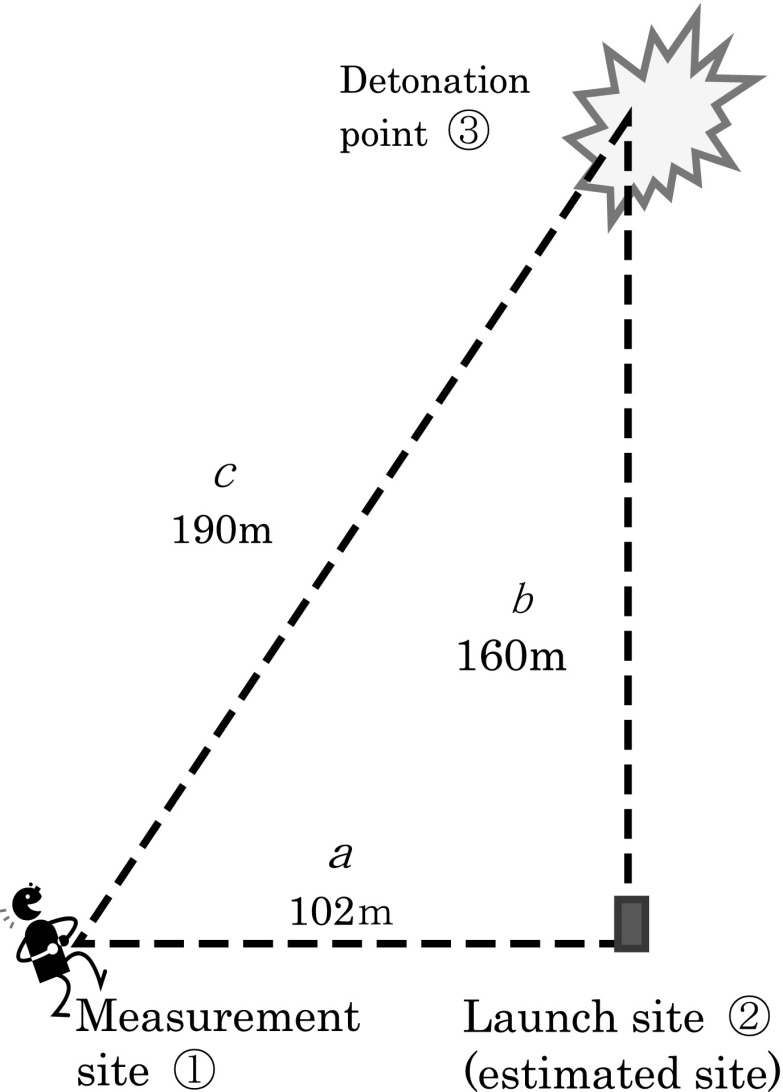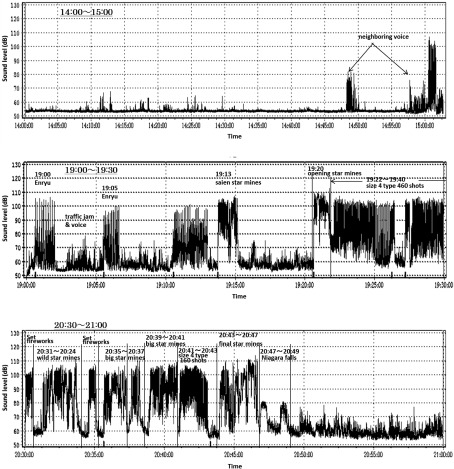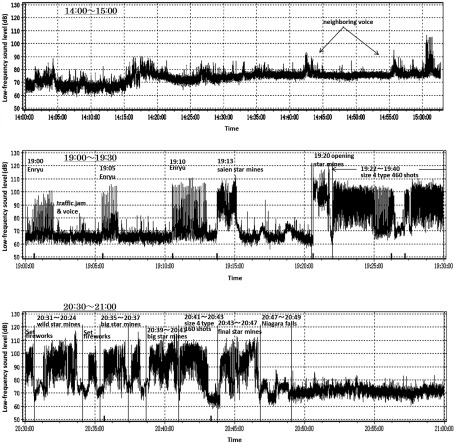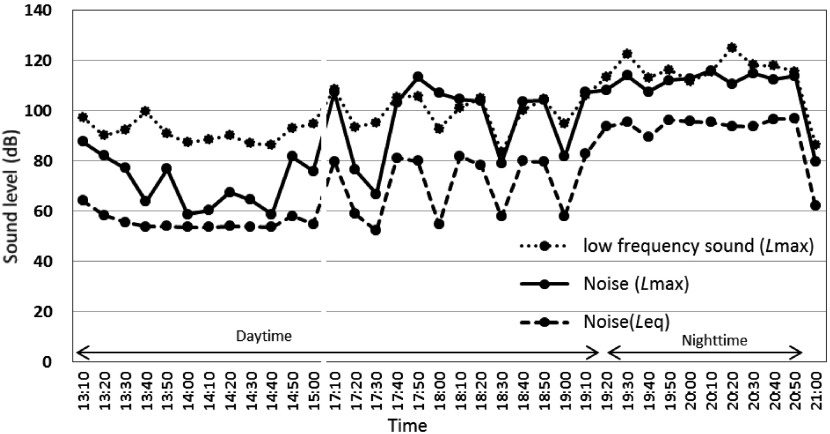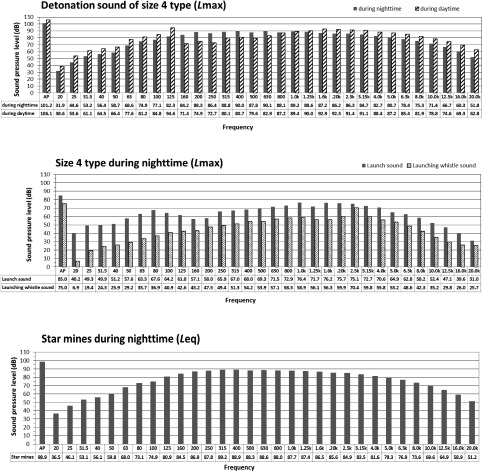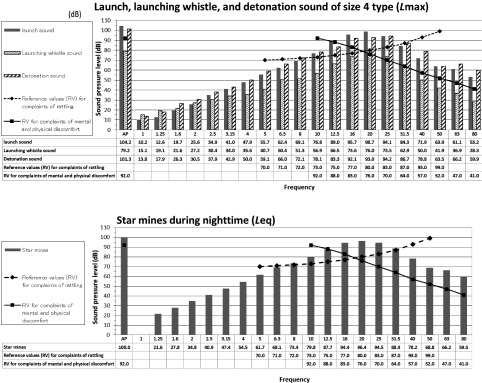Abstract
Objectives:
This study investigated the actual situation of noise and low-frequency sounds in firework events and their impact on pyrotechnicians.
Methods:
Data on firework noise and low-frequency sounds were obtained at a point located approximately 100 m away from the launch site of a firework display held in "A" City in 2013. We obtained the data by continuously measuring and analyzing the equivalent continuous sound level (Leq) and the one-third octave band of the noise and low-frequency sounds emanating from the major firework detonations, and predicted sound levels at the original launch site.
Results:
Sound levels of 100-115 dB and low-frequency sounds of 100-125 dB were observed at night. The maximum and mean Leq values were 97 and 95 dB, respectively. The launching noise level predicted from the sounds (85 dB) at the noise measurement point was 133 dB. Occupational exposure to noise for pyrotechnicians at the remote operation point (located 20-30 m away from the launch site) was estimated to be below 100 dB.
Conclusions:
Pyrotechnicians are exposed to very loud noise (>100 dB) at the launch point. We believe that it is necessary to implement measures such as fixing earplugs or earmuffs, posting a warning at the workplace, and executing a remote launching operation to prevent hearing loss caused by occupational exposure of pyrotechnicians to noise. It is predicted that both sound levels and low-frequency sounds would be reduced by approximately 35 dB at the remote operation site.
Keywords: Firework, Frequency analysis, Low-frequency sound, Noise, Occupational exposure, Pyrotechnician
Introduction
Fireworks are held everywhere in Japan during the summer season. Firework displays are a common feature of summer, with many renowned events organized on a yearly basis, and some reaching significant sizes. These displays attract numerous spectators across the country. Numerous pyrotechnicians work behind the scenes to bring entertainment to spectators.
Since firework displays involve explosion and auditory disorder risks1), safety distances are decided and set up at a predetermined distance from the launch site2). Also, instances of accidents3) caused by crowd movements or fires have been observed, although this is not the object of this study. Furthermore, pyrotechnicians' work in their working environments is challenging in terms of health and safety3). Despite the fireworks safety standards2), unfortunately, accidents involving pyrotechnicians do occur. Moreover, although the history of fireworks is long, to the best of our knowledge, there are very few detailed studies on firework noise measurement from the occupational health point of view. There are also few studies on the subject of the health effects of hearing impairment caused by firework noise.
However, the working conditions of pyrotechnicians are not always well understood; moreover, even though pyrotechnicians' work is close to detonations, the actual influences of noise and low-frequency sounds on pyrotechnicians as well as the related health risks caused by firework displays are not always obvious to them.
We, therefore, performed an analysis of the degree of noise and low-frequency sounds and their impact on pyrotechnicians.
Material and Methods
We conducted a study of a fireworks display (daytime period: from noon to 19:15, night-time: from 19:20 to 20:50) held in "A" City in July 2013. The study was performed at a point located approximately 100 m away from the launch site through continuous measurement of noise and low-frequency sounds before and during night-time.
Various types of fireworks were launched during the display. Fireworks used during daytime are mainly "signal" and "salute" types (sizes 3 and 4). Those fired during night-time are size 4 and rapid-fire series of bursts, and they are called "star mines". A size 3-type firework shell has a 9 cm diameter, 0.2 kg weight and can reach an altitude of 120 m; a size 4-type one has a 12 cm diameter, 0.5 kg weight and can reach an altitude of 130 m4). The total number of firework devices launched in this display was 30,000 (including star mines).
During the fireworks display, we measured the equivalent continuous sound level (Leq) and ran the one-third octave band frequency analysis of the detonation sounds caused by major fireworks. Additionally, the detonation sound levels at the launch and remote operation sites were predicted by formulae5) for determining noise attenuation over the distance covered by noise (Fig. 1).
Fig. 1.
Image of point location in case of size 4 firework
○ Launching noise prediction at the original launch site: L1 = L1'+10 × log10 (Q/4πa2)
L1: discharge sound level (dB) at launch site
L1': sound level (dB) at monitoring point
a: distance from monitoring point to launch site (102 m)
Since the launch site was made of ground and the sound field was a half-free space, "2" was used as the sound source's directional coefficient (Q).
○ Detonation noise prediction at original launch site: L2 = L2'-10 × log10 (Q/4πb2)
L2: sound level (dB) at launch site
L2': detonation sound level (dB): L2' = L1'+10 ×log10 (Q/4πc2)
L1': sound level (dB) at monitoring point
b: distance from launch site to detonation point
c: distance from monitoring point to detonation point
Since the detonation point gave sound a free space to travel, "1" was used as the sound source's directional coefficient (Q).
Noise was measured as A-weighted sound pressure level using a precision sound level meter Model NA-27 (JIS C 1509-1: 2005 Class 1, RION Co., Ltd., Tokyo, Japan), and the time constant in the analysis was FAST (125 msec). Data of noise and low-frequency sounds were analyzed using the data analysis software installed in the data recorder (Model DA-20, RION Co., Ltd., Tokyo, Japan). For low-frequency sound level measurements, we obtained the Leq, G-weighted sound pressure level, and one-third octave band sound pressure levels of the major firework detonations. Low-frequency sound levels were detected using a low-frequency sound level meter Model NA-18 (JIS C 1514: 2002 Class 1, RION Co., Ltd., Tokyo, Japan). The time constant was FAST (125 msec) to be easily compared to the noise. Frequency analysis measurements were carried out using a one-third octave band analyzer (waveform analysis software: Model CAT-WAVE, RION Co., Ltd., Tokyo, Japan).
Results
Real-time changes in firework noise and low-frequency sound levels
The real-time changes in sound levels during the fireworks display are shown in Fig. 2. Between 13:00 and 15:00, sound levels were observed at approximately 55 dB due to preliminary work at the firework launch site. At about 15:00, the maximum firework sound level was observed at more than 100 dB during the salute-type display. Moreover, sound levels were recorded at more than 100 dB when several aerial fireworks were detonated between 17:00 and 18:45. As the evening progressed, the noise that was caused by the crowd increased.
Fig. 2.
Time-dependent variation of noise caused by fireworks.
From 19:20 onwards at night, firework sounds were continuously observed for continuous firing of size 4-type fireworks and star mine-type fireworks fired in rapid succession. Sound levels of about 100-115 dB were observed owing to differences in durations depending on the type of fireworks fired. No significant differences in sound levels were observed among the groups of sequential fireworks.
Typical real-time variations of the low-frequency sounds are shown in Fig. 3. During daytime, the maximum sound pressure level for low-frequency sounds due to signal detonations exceeded 100 dB. The sound pressure levels of continuous fireworks during night-time were between 100 and 125 dB.
Fig. 3.
Time-dependent variation of low-frequency sounds caused by fireworks.
Equivalent continuous fireworks noise and low-frequency sound levels (Fig. 4)
Fig. 4.
Time-dependent variation of noise and low-frequency sound.
For every 10 minute period from the beginning of the daytime display at 13:10 to the end of the night-time period at 20:50, the recorded Leq and peak value (Lmax) are shown in Table 1. Similarly, the recorded Lmax and Leq for low-frequency sound levels are shown in Table 2.
Table 1.
Lmax and Leq of the noise caused by fireworks
| Noize (dB) | Daytime | Nighttime | ||
|---|---|---|---|---|
| Lmax | Leq | Lmax | Leq | |
| SD: standard deviation. | ||||
| Max | 113 | 83 | 116 | 97 |
| Min | 59 | 52 | 108 | 89 |
| Means | 85 | 64 | 112 | 95 |
| SD | 18.2 | 12.0 | 2.7 | 2.2 |
Table 2.
Leq of low-frequency sound level
| Low frequency sound (dB) | Lmax | |
|---|---|---|
| Daytime | Nighttime | |
| SD: standard deviation. | ||
| Max | 109 | 125 |
| Min | 83 | 112 |
| Means | 96 | 117 |
| SD | 7.2 | 4.2 |
The Leq of noise for every 10 min period of sporadic launches during the daytime had an average of 64±12 dB (SD). However, the Leq during night-time increased with the sounds of continuous firework detonations. The maximum Leq was 97 dB, the minimum Leq was 89 dB, and the average value was 95±2.2 dB (SD). The maximum Lmax for the night-time was 116 dB, with a minimum of 108 dB and an average of 112±2.7 dB (SD).
In addition, the highest Lmax for low-frequency sounds during the night-time was 125 dB, with a minimum value of 112 dB and an average value of 117±4.2 dB (SD).
Frequency analysis of fireworks noise
A wide variety of firework types were launched during the display. We performed frequency analyses for all firework sounds we were capable of collecting individually, excluding serial detonation sounds most likely attributable to star mines; the results are shown in Fig. 5.
Fig. 5.
Frequency distribution of fireworks noise. AP: all pass
The noise was slightly lower at frequencies between 160 and 200 Hz for launching sounds. The noise at the 2.5 kHz band was approximately 10 dB higher than that at the other frequencies; this is characteristic of whistles caused by launches. Regarding the detonation sounds due to size 4 and 3 fireworks during night-time, these were distributed over the whole frequency spectrum. By contrast, the sound for type 4 fireworks was predominant in low-frequency bands below 125 Hz during the daytime. The sound frequencies for successive star-mine launches were analyzed by Leq: a distribution of a specific frequency could not be observed; rather, this showed a uniform distribution over the entire frequency spectrum.
Therefore, the frequency distribution of observed sounds was different in the stages from launch to detonation or in the firework size types. Several frequency distribution patterns were observed.
The frequency analysis of low-frequency sounds is shown in Fig. 6. Detonation and launch whistle sounds from size 3 fireworks during the day displayed lower sound-pressure levels compared to other firework noises, but the fireworks launching noise, launch whistle noise and detonation noise showed a peak distribution pattern within a 16-25 Hz frequency range. Moreover, in these frequency bands, with the exclusion of the launch whistle sounds, launching, detonation, and star-mine sounds exceeded both the reference values for complaints of rattling6) and those for complaints of mental and physical discomfort6) established by the Ministry of the Environment (Fig. 6). Both launching and detonation sounds exceeded the reference value for complaints of rattling for the 10-25 Hz range. In addition, these sounds exceeded the reference value for complaints of mental and physical discomfort for the 16-80 Hz range.
Fig. 6.
Frequency distribution of fireworks' low-frequency sound. AP: all pass
Predicted noise and low-frequency sounds at the launch and remote operation sites
The predicted noise and low-frequency sound levels calculated based on the formulae for noise and low-frequency sounds at the launch and remote operation sites are shown in Table 3.
Table 3.
Simulated sound level at the launch and remote operation sites
| Fireworks | Measured value (dB) | Forecasted value (dB) | Reduction by remote operations (dB) | Reaching altitude (m) | Monitoring time | ||||
|---|---|---|---|---|---|---|---|---|---|
| Detonation point | Launch site | Remote operation site | |||||||
| 20 m | 30 m | ||||||||
| Launching sounds (Size 4 type at night) | Noise Low frequency sound | 85 104 |
- - |
133 152 |
99 118 |
96 115 |
34-37 34-37 |
- | 19:35:14- |
| Detonation sounds (Size 4 type at night) | Noise Low frequency sound | 101 101 |
158 158 |
102 102 |
102 102 |
102 102 |
0 0 |
160 | 19:34:30- |
| Detonation sounds (Star mine type) | Noise Low frequency sound | 99 100 |
153 155 |
101 102 |
101 102 |
101 102 |
0 0 |
120 | 19:13- |
| Nighttime sounds (19:20-20:50) | Noise Low frequency sound | 94 96 |
151 152 |
96 98 |
96 98 |
96 98 |
0 0 |
160 | - |
| Launching sounds (Size 3 type in daytime) | Noise Low frequency sound | 82 98 |
- - |
130 146 |
96 112 |
93 109 |
34-37 34-37 |
- | 15:00:37- |
| Detonation sounds (Size 3 type in daytime) | Noise Low frequency sound | 101 95 |
156 150 |
104 97 |
103 97 |
103 97 |
1 0 |
120 | 15:00:40- |
Since the launching noises (for size 4 fireworks during night-time) detected at the measurement point were 85 dB (measured maximum value), the detonation sounds at the launch site were estimated to be 133 dB. Occupational exposure to noise for pyrotechnicians at the remote operation point (located 20-30 m away from the launch site) was estimated to be below 100 dB, a 34-37 dB decrease in sound level by remote operation.
In addition, the predicted detonation sound level calculated from the detonation sound (101 dB) at the noise measurement point was 158 dB, and the predicted noise at the launch site was 102 dB. Moreover, the sound level at the remote operation point 20-30 m away from the launching point was also 102 dB. There was no difference between the predicted sound levels at the launch and remote control sites.
The low-frequency sound level at the launching point when firing was predicted to be 152 dB from the maximum measurement level obtained from size 4 fireworks' launching sound levels (104 dB). Then, exposure to low-frequency sound for pyrotechnicians at the remote operation point was estimated to be 118-115 dB; in effect, a 35 dB approximate decrease in low-frequency sound levels by remote operation.
Discussion
Various types of fireworks were launched during the continuous measurement period of the display. We have carried out a frequency analysis of noise and low-frequency sounds for the single sound of the Lmax of these fireworks. In addition, we performed frequency analysis of noise and low-frequency sounds for the Leq of continuous fireworks (star mines). Since the impact sound caused by fireworks is an instantaneous explosion, it is difficult to observe the instant of the sound of the explosion.
The method we used was aimed at facilitating data collection going forward; in this study, the subjects used to evaluate the effect of impact noise are labor and people, enabling us to make an evaluation close to human perceptions and to compare them to "Practice based on measurement results for work areas excluding indoors" as presented in the "Guidelines for the prevention of noise-induced impairments, Ministry of Health, Labor and Welfare of Japan (1992)." 9)
To remove the risk of accidents caused by cylinder spring or direct firework hits, and as a safety precaution, it has been recommended that operations be carried from a remote location 20-30 m away from the launch site2).
In the remote operation site, it is estimated that both the noise and low-frequency sound levels would be reduced by approximately 35 dB. Thus, it is confirmed that pyrotechnicians could significantly reduce the level of firework noise exposure by remote operation of firework launches. It is considered that pyrotechnicians could not only prevent accidents due to fireworks by remote launch operations, but they could also get the benefits of noise hazard reduction. Airburst firework detonation sounds were similar in sound levels at the measurement point and both the launch and remote control sites. There were no observable differences in the predicted noise or low-frequency sound levels between the fireworks of different sizes. Because the firework shells burst at higher altitude as their size becomes larger, there are no large differences in noise and low-frequency sound levels on the ground. Therefore, we think that hearing protection for the pyrotechnicians is required more against launching noises than against detonation noises.
We believe that remote operation of firework launches will not only prevent accidents such as firework strikes but will also significantly reduce the exposure of pyrotechnicians to hazardous noise.
The Japan Society for Occupational Health provided "Occupational exposure limits (OELs) for impulsive or impact noises by A-weighted sound pressure level (chapter 7, part ii) " in its "Recommendations of OELs (2015-2016) " 7). In these recommendations, it was revealed that "in case total frequency of exposure to impulsive or impact noises is at or below 100 times a day, the acceptance criteria of sound levels (A-weighted sound pressure levels) is 120 dB." Since it is determined that "in case the total number of exposures to impulsive or impact noises exceeds 100 times a day, the sum of the peak sound pressure levels with a correction value for the difference in exposure frequency is recommended as an OEL." Therefore, since the impulsive and impact exposure for this fireworks display was approximately 30,000 times, the exposure limit is 87 dB with an added correction value (-33 dB). The noise exposure levels to the pyrotechnicians observed in this environment of fireworks display greatly exceeded the impulsive or impact exposure limits. Adequate noise reduction at the remote operations point (at a distance of 20-30 m from the launch site) cannot be successfully ensured. For this reason, we recommend that pyrotechnicians should be fitted with hearing protection such as earplugs or earmuffs; furthermore, we think it is necessary to explicitly display warnings regarding the hazards of the work area. However, because a successful firework detonation (or dud firework) has to be determined by sound, and contact among technicians is done verbally, use of earplugs or earmuffs may increase rather than decrease the exposure of pyrotechnicians to workplace hazards8).
The predicted value of the sound level at the launching point was the one set by the "Administrative classification III" of the "Guidelines for the prevention of noise-induced impairments (1992) " 9) in noisy environments. Since shooting sounds at the launch site are especially loud, it is important to prevent noise-induced hearing loss as an occupational disease for pyrotechnicians by thorough and explicit action such as wearing earplugs, earmuffs, or other hearing protectors, and posting a warning about extreme noise at the workplace.
The noise or low-frequency sound levels caused by detonation sounds in mid-air makes almost no difference to pyrotechnicians and the general audience. However, it is necessary to increase sound protection by avoiding operations directly at the launch site; thus, it is possible to expect a significant reduction of noise and low-frequency sound by operating at a remote location 20-30 m away from the firework launch site. Therefore, we consider that remote firing operations by electric ignition are desirable in terms of hearing loss protection for pyrotechnicians.
Moreover, the purpose of this study was evaluating the effect of launch fireworks on pyrotechnicians. As noise measurements carried out in this study are not easily obtainable, this study was presented as a possible way of determining the power level of noise generated by the launch of fireworks and their airborne explosions. Then, with reference to the measures shown in the above guidelines, we measured the power level of the explosion as we could predict the noise to which workers at the actual site were exposed. In this study, we estimated the sound level at the remote operation site of launch fireworks by this power level. Going forward, we believe that it is possible to consider noise abatement methods required by a remote control location.
This study had several limitations. First, since the launch site was a restricted area, we could not directly measure the noise and low-frequency sounds. Originally, the measurement should have been performed at the site where pyrotechnicians were exposed to noise and low-frequency sounds. Second, fireworks launched in this firework display were mostly size 3- or 4-type and star mines. Therefore, we could not measure the noise and low-frequency sound of larger size-type fireworks.
Conclusions
We believe that this study gives a good approximation of the generation of noise and low-frequency sounds due to fireworks. The shooting noise at the launching site results in a very loud level in excess of 100 dB. To prevent the health issues caused by hearing loss, which is an occupational disease for pyrotechnicians, it is important to take measures such as wearing ear protectors, displaying a warning on the workplace, and remote launching operation. We think it is necessary to give sufficient consideration to the effects caused by launch sounds of fireworks.
Acknowledgments: The authors thank Adjunct Lecturer Atsushi Hioki, Gifu University, for his generous and valuable advice regarding this study.
Conflicts of interest: The authors have nothing to declare on conflicts of interests.
References
- 1). Oeken J. Distortion product optoacoustic emissions in acute acoustic trauma. Noise & Health 1998; 1: 56-66. [PubMed] [Google Scholar]
- 2). Japan Pyrotechnics Association Enka-no shouhi-hoan kijun [Consumption and security standards for fireworks]. 2nd ed, Tokyo (Japan): 2013. p. 5-7 (in Japanese). [Google Scholar]
- 3). Inaba R. Enforcement situation of preventive measures against heat disorders among enterprises setting fireworks. JJOMT 2013; 61: 319-323. [Google Scholar]
- 4). Tei T. The sound of fireworks. J INCE/J 2010; 34: 281-286 (in Japanese). [Google Scholar]
- 5). Kakei H. Introduction of noise prediction calculation. Idemitsu technical report 2007. No. 50: 21-28 (in Japanese). Available from: URL: http://www.idemitsu.co.jp/content/100136813.pdf [Google Scholar]
- 6). Ministry of the Environment Government of Japan Evaluation guide to solve low frequency noise problems. [Online]. [cited 2015 Dec. 14]; Available from: URL: https://www.env.go.jp/en/air/aq/low_noise2004/03.pdf
- 7). Japan Society for Occupational Health Recommendation of occupational exposure limits (2015-2016). J Occup Health 2015; 57: 394-417. [DOI] [PubMed] [Google Scholar]
- 8). Inaba R. Uchiage-hanabi to kenko [Aerial fireworks and health]. Japan Health Medicine Association 2012; 20: 214-217 (in Japanese). [Google Scholar]
- 9). Ministry of Health, Labour and Welfare of Japan Guidelines for the prevention of noise-induced impairments (1992). [Online]. [cited 2015 Dec. 14]; Available from: URL: https://www.jniosh.go.jp/icpro/jicosh-old/english/guideline/Guide-1.html



